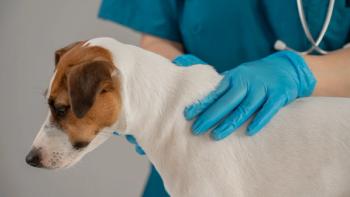
Dermatologic tests: tips and tricks (Proceedings)
Skin and ear problems are very common reasons for dogs and cats being presented to a veterinarian. These animals can suffer from many different skin diseases with a wide range of underlying causes. Because the skin has a limited range to react to the different insults a straight-forward diagnosis is commonly not possible, especially in patients with chronic skin diseases.
Skin and ear problems are very common reasons for dogs and cats being presented to a veterinarian. These animals can suffer from many different skin diseases with a wide range of underlying causes. Because the skin has a limited range to react to the different insults a straight-forward diagnosis is commonly not possible, especially in patients with chronic skin diseases. To identify the underlying diseases it is crucial that a thorough history is obtained followed by a series of diagnostic tests. Although many of the tests used in veterinary dermatology appear simple, it still requires that microscopes are properly used, slides are stained sufficiently, and samples are handled correctly. However, you should always keep in mind that tests are rarely 100% reliable. This is especially true in patients with obvious lesions but negative test results. For this reason it is important to take the time to perform these tests properly and to become experienced in evaluating your test samples so that you and your veterinarian will be a successful team.
Methods of finding ectoparasites
a) Flea combing/Coat brushing:
• Indication: pruritic animals, seborrheic skin, previous history of fleas
• Look for: Fleas, lice, Cheyletiella, and their eggs
• Combs should be washed after each use and kept in a container with a disinfectant to prevent contamination and transmission of infectious diseases (e.g. dermatophytosis)
b) Paper towel test (only fleas):
• Look for: flea dirt in material obtained from brushing
• It is not unusual that fleas cannot be seen, but flea dirt very often indicates a situation of flea infestation if an animal has an infestation flea dirt (feces) can be found in most cases. The fecesis composed of digested blood which explains, that it dissolves in water and leaves behind red- brownish stains discoloration on white paper tissues
c) Skin scraping:
• Indication: Pruritus, alopecia, seborrhea, papulo-pustular eruptions, erosions
• Method: Use a #10 blade → dip the blade in mineral oil or apply a drop onto the skin → transfer the sample onto a microscope slide → put a cover slide on top → microscopic examination at x4-x10 with the condenser turned down
• Look for: Demodex, Cheyletiella (broad head with 2 large hooks), Sarcoptes (short legs with long stalks), Notoedres, Otodectes (ear mites; long legs and very short stalks), Chigger mites (3 pair of legs)
• Demodex: because these mites live in hair follicles deep skin scrapes are necessary. Sometimes these mites are located deep in the hair follicle (especially in the skin of the feet) which makes it hard to find them. Since Demodex mites are a part of the skin flora, it usually requires the presences of multiple mites to consider the findings relevant. Squeezing the skin prior to scraping increased the chance of finding the mites
• Other parasites: these parasites live on the skin surface but tend to be present in lower numbers than Demodex (the presence of one single parasite is diagnostic!). For these reason multiple superficial and larger areas should be scraped
d) Unstained adhesive tape strips:
• Indication: Pruritus or scaling
• Look for: Lice, Cheyletiella ("Walking dandruff"), and Chigger mites
e) Ear smear for aural parasites:
• Indication: Otitis, pruritic ears with brown-black crumbly discharge
• Look for: Otodectes, Demodex (rare)
f) Cytology:
• Indication: Pruritus, seborrhea, pustules, ulcers, draining tracts, non-healing wounds, otitis or lumps/swelling
• Techniques: Cotton swab (draining tract, ears), acetate tape impression (especially for dry, difficult to access lesions), direct impression smear, fine needle aspiration (mass, tumor, abscess, large vesicles/pustules), skin scraping. Most common in-house stain is Diff Quick. High power (x100 with immersion oil) is used to evaluate microorganisms. Evaluate 5-10 HPF (high power fields) and score them either by averaged number of organisms or by giving a score of + to ++++.
• Look for: Bacteria (cocci and rods), Malassezia yeast, other fungal organisms (e.g. Sporothrix, Blastomyces), acantholytic cells (e.g. Pemphigus foliaceus), inflammatory cells (e.g. neutrophils, macrophages, eosinophils, mast cells), and neoplastic cells
g) Trichogram:
• Indication: Alopecia, pruritus, seborrhea, broken hairs
• Look for: Demodex, lice, Cheyletiella, parasitic eggs, dermatophytes (fungal spores and hyphae), melanin clumping in hair (e.g. color dilution alopecia), nodular hair fracture (e.g. Trichorrhexis nodosa)
h) Wood's lamp:
• Indication: Dermatophytes ("Ringworm"); should be performed on every cat with skin lesions and coat abnormalities
• Look for: Fluorescing hair. Only positive in ~50% of Microsporum infected animals. M. gyspeum and Trichophyton spp. are not Wood's lamp positive
• Note: Only bright apple-green glowing hair should be considered positive.
i) Dermatophyte test medium (DTM):
• Indication: If Wood's lamp positive and/or dermatophytosis is suspected
• Technique: use sterile hemostats to plug hairs from the periphery of a lesion or use a toothbrush for diffuse lesions or follow-up exams. Most commonly used culture media are DTM and Sabouraud's dextrose agar. Dermatophytes grow best at 80°F, >50% humidity, and no UV light exposure. Monitor daily for at least 3 weeks for color change (red) and grow of colonies. Colony must be whitish and cotton-like. Colonies must be examined microscopically (dermatophytes produce species-specific macroconidia (spores)) which will help to make a final diagnosis
j) Bacterial/Fungal culture & Sensitivity:
• Indication: Skin infections that have failed to respond to appropriate treatment, draining tracts, nodular, granulomatous lesion, unusual microorganisms on cytology (rods, filaments, hyphae)
• Technique: Sterile culture swab & acetate tape impression (aerobic), skin biopsy & aspirates under aseptic condition (aerobic an anaerobic). Do not refrigerate, ship overnight, follow instruction for shipping (e.g. biohazard label)
k) Biopsy and histopathology:
• Indication: Lesion appears unusual, serious, with unexpected behavior, or not responding to therapy; persistent erosions, ulcers, draining tracts, lumps, swelling, or nodules; suspected neoplasia, or auto-immune disease; alopecia, scaling, eruptions not diagnosed by preliminary tests; depigmentation or unexplained hyperpigmentation
• Technique: Choice of biopsy sites depends heavily on the type of skin lesions! Early active lesions will yield the best results. Punch biopsies (6-8 mm diameter) are used for intradermal lesions, and wedge biopsies for larger nodular and subcutaneous lesions. Do not scrub biopsy site if lesion is superficial. Use 3-0 Vicryl or PDS for closure of biopsy site. The more biopsies are taken the more likely you will end up with a diagnosis. Biopsy sample must be placed into formalin immediately to prevent degradation of tissue. The pathologists would appreciate if you provide them with a little bit of the patient's history.
Newsletter
From exam room tips to practice management insights, get trusted veterinary news delivered straight to your inbox—subscribe to dvm360.





